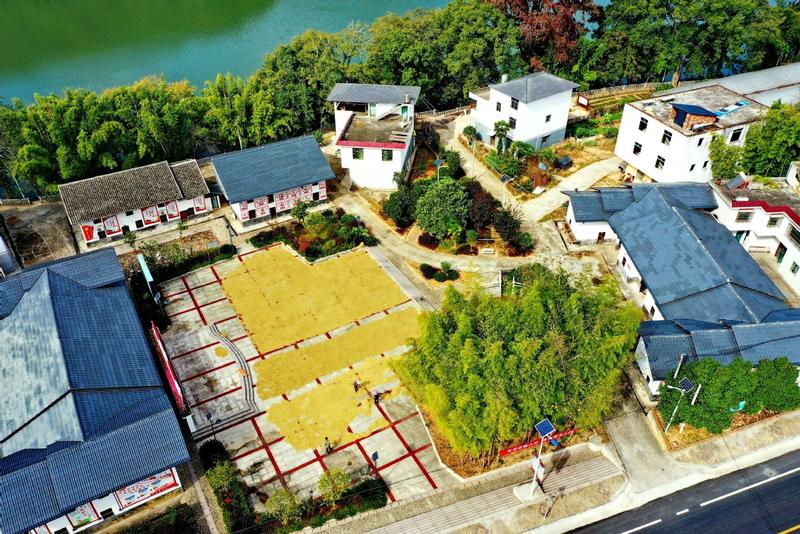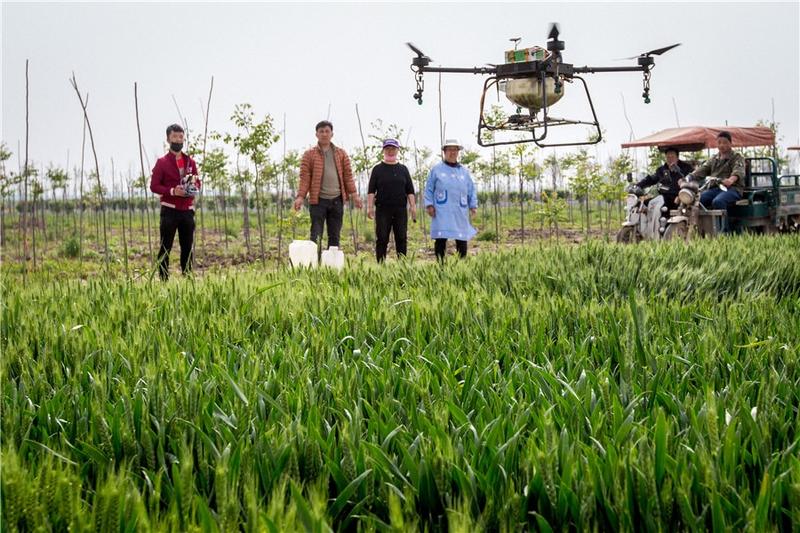 This undated photo shows unhusked rice spread out on a square in Daxiba village, Huichang, during the November harvest season. (ZHU HAIPENG / FOR CHINA DAILY)
This undated photo shows unhusked rice spread out on a square in Daxiba village, Huichang, during the November harvest season. (ZHU HAIPENG / FOR CHINA DAILY)
As China has removed the last remaining counties from the poverty list, the nation will shift the focus from poverty eradication to rural vitalization to improve living conditions in rural areas.
Tang Renjian, minister of agriculture and rural affairs, stressed on Monday the consolidation of poverty alleviation results when introducing the No 1 central document for 2021, which was released on Sunday and prioritizes rural vitalization.
"The document highlighted the significance of a smooth transition from poverty eradication to rural vitalization. It ensures that no large scale poverty will ever happen again," Tang said.
The priority of the Ministry of Agriculture and Rural Affairs during the 14th Five-Year Plan (2021-25) will be stabilizing and developing poverty alleviation outcomes and smoothly pivoting to rural vitalization
ALSO READ: Nation works to modernize rural areas
Poverty eradication is not the final goal but a starting point for new life and new endeavors.
Although the population has shaken off poverty and their needs are being met, they are still vulnerable in terms of having their self-development fulfilled as long as industrial support is not sufficiently strong, he added.
So the ministry's priority during the 14th Five-Year Plan (2021-25) will be stabilizing and developing poverty alleviation outcomes and smoothly pivoting to rural vitalization.
China will set a five-year transition period for counties that have already shaken off poverty. Current poverty alleviation measures will remain during the period to realize the gradual transition, according to the document.
Early detection and intervention should be conducted to prevent people in rural areas from returning to poverty.
"Developing and upgrading local industry with an influx of technology, facilities and financing is expected to be the dominant solution to help people live a wealthier life," Tang said.
He added that China will promote the employment of the 9.6 million people who were relocated to get rid of poverty and increase their income by providing nearby jobs.
Implementation of infrastructure projects, along with other supportive measures such as pairing of and cooperation between eastern and western regions, will be used in areas that have shaken off poverty, according to the document.
READ MORE: Xi urges efforts on rural vitalization
The country will also start implementing new plans for the modernization of agriculture and the countryside.
China will launch a series of key projects and activities to improve rural residents' living environment and boost rural consumption as ways to achieve rural modernization
"To promote agricultural modernization, China will strive to address issues regarding seeds and arable land and the development of modern agricultural technology as well as farming equipment," Tang said.
Modernization
The country will also launch a series of key projects and activities to improve rural residents' living environment and boost rural consumption as ways to achieve rural modernization.
Wu Hongyao, a senior official with the ministry, said implementing the rural construction plan is an important way to realize the goal.
"The rural construction plan should include both hardware and software development. The hardware refers to better rural public infrastructure and software means access to public services. Meanwhile, we need to promote integrated urban-rural development within counties," Wu said.
READ MORE: How China can achieve modernization goal
With the garbage problem in rural areas having been basically solved in recent years, more efforts should be made to deal with troubles with toilets and sewage treatment in the countryside, he added.
"Rural construction is not for you and me, but for farmers. Their needs and feelings and the real situation of rural areas must be taken into consideration," Tang said.
 In this undated photo, people watch as a drone sprays pesticide and fertilizer on a wheat field in Anyang, Henan province. (PHOTO PROVIDED TO CHINA DAILY)
In this undated photo, people watch as a drone sprays pesticide and fertilizer on a wheat field in Anyang, Henan province. (PHOTO PROVIDED TO CHINA DAILY)
Highlights of No 1 central document
According to the new policy document released on Sunday:
Grain output will reach 650 billion kilograms this year.
A total of 6.67 million hectares of farmland resistant to floods and drought will be established this year.
About 500 pilot zones for modern agriculture will be set up by 2025.
The tap water coverage rate will reach 88 percent in rural regions by 2025.
All problematic reservoirs will be renovated and reinforced by 2025.
A "relatively complete" credit system will be built by 2024 to serve stakeholders in agricultural operations.
Authorities in provincial-level regions will report annually to central authorities on progress in rural revitalization.
A five-year "transition period "will be created for counties that recently escaped extreme poverty.
China will move ahead with reforms in the collective land ownership system in the countryside.
China will see "important progress" in modernizing agriculture and rural regions before 2025.
China will in principle finish territorial spatial planning at the county level this year, an effort that will help determine the layout of villages and classification of lands.
China will ramp up legislation and supervision for the construction of farmers' homes and will work to rule out risks in three years.
Li Lei contributed to this story.


